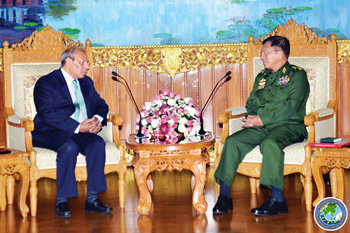INDIAN ARMED FORCES CHIEFS ON
OUR RELENTLESS AND FOCUSED PUBLISHING EFFORTS

SP Guide Publications puts forth a well compiled articulation of issues, pursuits and accomplishments of the Indian Army, over the years

I am confident that SP Guide Publications would continue to inform, inspire and influence.

My compliments to SP Guide Publications for informative and credible reportage on contemporary aerospace issues over the past six decades.
- Interim Defence Budget 2024-25 — An Analysis
- Union Defence budget 2024
- Indian Army: In quest of greater firepower and policy recommendations for gaps
- Indian Army Annual Press Conference 2024
- 6G will transform military-industrial applications
- Tata Boeing Aerospace Delivers 250 AH-64 Apache Fuselages, Manufactured in India
Indo-Myanmar CT cooperation
 |
By Lt. General P.C. Katoch (Retd) Former Director General of Information Systems, Indian Army |

John Swinton, the former Chief of Staff at the New York Times, called 'The Dean of His Profession', said during his farewell speech in 1953, "There is no such thing, at this date of the world's history, as an independent press. You know it and I know it. There is not one of you who dare to write your honest opinions, and if you did, you know beforehand that it would never appear in print.... The business of the journalist is to destroy the truth; to lie outright; to pervert; to vilify; to fawn at the feet of mammon, and to sell the country for his daily bread. ... We are the tools and vassals of the rich men behind the scenes. We are the jumping jacks, they pull the strings and we dance. Our talents, our possibilities and our lives are all the property of other men. We are intellectual prostitutes." This applies to the Indian media too.
But when post the Indian Special Forces raid on insurgent camps in Myanmar when the Myanmar media stated their permission was not sought to undertake the cross-border raid, it was for a different reason. No sovereign country would admit this for the sake of public opinion, especially Myanmar with elections slated within a few months. Next came the news in the Indian media that post the visit of our NSA to Myanmar to tie up joint Indo-Myanmar operations against the Naga and other insurgents lodged inside Myanmar territory did not get the expected response from the Myanmar government despite the NSA having held comprehensive talks with Myanmar President U Thein Sein and top defence brass. The NSA's visit was post the June 9 raid by Indian Special Forces inside Myanmar pursuant to the ambush of an army convoy in Manipur that resulted in the loss of 18 personnel. Media reported Myanmar authorities told the NSA that while NSCN was confined to border areas, the hot pursuit by the Indian Army forced them to move further inside the country, which affected Myanmar security. This report was apparently untrue as proved by follow up events.
On June 25 came news of the Myanmar Army closing in on the militant camps operating in Myanmar, positioning itself near the Indo-Myanmar border in a bid to choke the supply route of insurgents. This operation is aimed at insurgent camps operating in Taga of Myanmar which requires seven days of travel through dense jungles from the Indo-Myanmar border, Taga having camps of several insurgent outfits including NSCN(K) and UNLF. The insurgents operating in the region often threaten villagers asking them to provide them with daily provision, food supplies and intelligence. In conjunction both Indian and Myanmar Armies, the cross-border movement of civilians is being choked. Deployment of the two armies in proximity of each other increases mutual understanding and facilitates coordinating operations against insurgents.
On June 25, Senior General Min Aung Hlaing, C-in-C of Myanmar Defence Services received Indian Ambassador to Myanmar, Gautam Mukhopadhaya at his villa in Nay Pyi Taw and stressed the importance of: bilateral communications between the two armies at the border; ensuring good relations; joint combing operations, and; actual meetings between the armed forces of the two nations. He also added that the role played by personnel at the border was of vital importance in maintaining closer bilateral relations between the two countries for peace and stability at the border. A high-level military delegation from Myanmar, headed by the Commander-in-Chief of Myanmar's Armed Forces will visit New Delhi later this month to chalk out a joint strategy against insurgents operating along the Indo-Myanmar border as well as in the Sagiang division of Myanmar. The decision to send the military delegation to India was taken after a meeting with the top leadership of Myanmar during visit of our NSA, Foreign Secretary and Eastern Army Commander to that country. President Thein Sein, assured the Indian delegation that insurgents group from India's north-east will not be allowed to use Myanmar's territory for anti-India activities albeit Myanmar Army presence along the Indian border is thin on the ground.
India too has stepped up its vigil along the border and is sharing real-time intelligence about the movement of insurgent groups. Significantly, Myanmar has indicated it is not be averse to "joint operations" with the Indian Army in border areas. This has been a significant initiative by the Modi Government. This must be followed up by speedily resolving the border issue and demarcating it.





